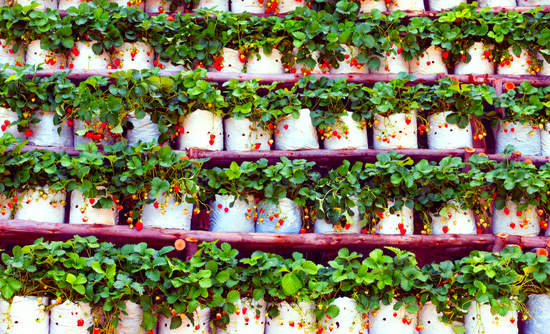Vertical Farming, continued
This is page 6 of our nine page series on hydroponic vertical farming. Click any of the below pages to jump to that page.
Page 1 Page 2 Page 3 Page 4 Page 5 Page 6 Page 7 Page 8 Page 9

Vertical farming strawberries, growing in hydroponic bags. These are an uncommon crop for vertical farming, but it can be done with some careful work. We cannot tell from this picture what the growing media is, but it could be anything suited to what strawberries need most - solid anchoring, good drainage, and frequent irrigation. Given that the bags are stacked on shelves, the growing media is probably not as heavy as sand, gravel or hydroton, but rather something lighter weight such as a form of rockwool, coir or a perlite/vermiculite combination. Photo courtesy of a Greenbiz.com article on vertical farming.
Which Crops Don’t Work in the Vertical Farming Systems?
As we described on previous pages, some crops would not work well in vertical farming systems, due to the space they’d take up. Tall, large, bushy crops take up enough space between trays and/or alongside, that they cut into the benefits which stacked trays otherwise provide.
I did want to discuss two plants which may work just fine in some hybrid-type vertical farming setups. First is the tomato. This crop presents something of a dilemma for growers, because it’s a high-value crop, which prefers to grow vertically, but doesn’t lend itself well to the more commonly used vertical growing techniques (such as NFT and flood/drain). One scenario where they could work in a quasi-vertical-farming scenario is to be grown in a bucket-system, and trellised. They are happiest when trellised anyway, and their vining habit allows for dense vertical plantings. They can also have high enough market demand, and high enough pricing, to make more elaborate plantings cost effective. Commercial tomato greenhouses already have a very well proven method of running each vine up a trellising line, and pruning the growing tresses down to only the minimum required to support fruit production. As the fruits mature and the plants’ growing tips produce new green leaves and new blossoms, they are allowed to advance up the trellis line. That line is regularly unspooled from where it is gathered at the top, such that both the leaf and the fruit are always at the optimal height. As the old growth is pruned away and the fruits harvested, the naked vines are actually laid on the ground and wrapped around the base. Those vines can become dozens of feet long, and the plants produce for 18 to 24 months, before they are finally retired in favor of younger plants. This arrangement is already very close to what vertical farming promises, with few of the disadvantages listed above.
Second is the strawberry. Strawberries can
work very well in several different hydroponic setups, as long as their
branching habit is considered and accommodated.
Whether growers are working on producing daughter plants, fruit or both,
strawberries will need room off to each side.
If NFT channels are used, the channels may need to have more space
between racks both above/below and from side to side. Spacing above/below is crucial not because of
the height of the plants, but rather because their fruit and/or daughter plants
will hang down low enough to interfere with the next lower tray. Spacing alongside is also critical so that
either the daughter plants and/or the fruit are not damaged or bruised by
frequent contact as workers brush by. If
strawberries are instead raised in buckets or bags, the height issue goes away because
the containers themselves are tall enough to create the heights needed for the
drooping plants/fruits. That arrangement
would still need sufficient extra width between racks so that fruits and/or
daughter plants are not damaged by frequent contact. The shelves would also need to be heavy-duty to carry the weight of the growing media.
BACK NEXT
This is page 6 of our nine page series on hydroponic vertical farming. Click any of the below pages to jump to that page.
Page 1 Page 2 Page 3 Page 4 Page 5 Page 6 Page 7 Page 8 Page 9